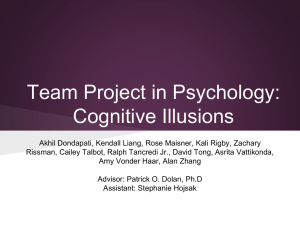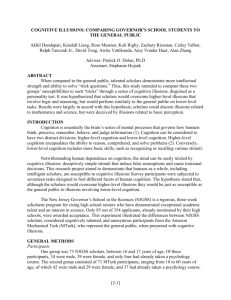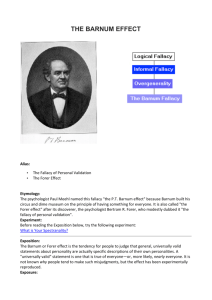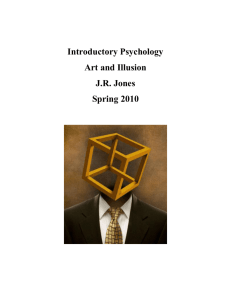T2 Final Presentation
advertisement
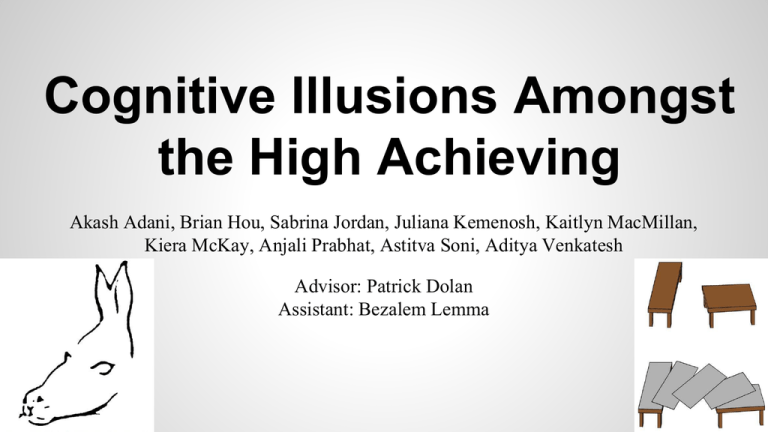
Cognitive Illusions Amongst the High Achieving Akash Adani, Brian Hou, Sabrina Jordan, Juliana Kemenosh, Kaitlyn MacMillan, Kiera McKay, Anjali Prabhat, Astitva Soni, Aditya Venkatesh Advisor: Patrick Dolan Assistant: Bezalem Lemma Introduction ● Cognition: mental processes involved in learning, memorizing, and decision making ● Cognitive Illusions: deception of senses to elicit false interpretation Introduction ● Comparison of NJGSS students and the general population ● Hypothesis: NJGSS students will be less susceptible to memory and logic related questions, but will be equally as susceptible to visual and lower-level illusions. Methodology ● Participants: o 75 Governor’s School scholars (NJGSS)-7/18/2015 o 75 anonymous subjects from Amazon Mechanical Turk (MTurk) ● Procedure: o Online survey disguised as a personality test o Link to survey released online for MTurk subjects o Administered in half-hour sessions for NJGSS subjects Methodology ● Statistical Analysis: o 2-proportion z-tests: analyze the difference between two proportions o 0.05 significance level Cognitive Tasks ● 16 different tasks/illusions ● 24 “filler” personality questions ● 4 main categories of tasks: o Sensation/Perception/Attention o Memory o Judgment/Decision-Making o Self-Perception ● The following slides present a summary of 6 out of the 16 tasks Change Blindness ● Subjects shown a video of a conversation o o Some were warned of editing mistakes Some were told to simply watch carefully ● Several major changes in the video Change Blindness ● Statistical difference between warned NJGSS students and the control group Moses/Semantic Illusion ● ● ● ● Semantic similarity- similar denotation/logic Brain does not pick up on change of key word Easy questions first Semantic Questions: ○ Not math related ○ Math related Moses/Semantic Illusion What is the name of the man in the red suit and long white beard who rides a sleigh and gives out birthday presents? Blue= NJGSS Red= Control Moses/Semantic Illusion What shape has a circumference of 𝛱r2 Blue= NJGSS Red= Control Memory for Words Lawyer Clinic Health Medicine Sick Stethoscope Cure Nurse Surgeon Patient Hospital Dentist Physician Ill Office False Memory ● A list of words, similar in either topic or a particular word ○ Associative memory causes subjects to put word not on list ● Subjects asked to read list and pick out favorite word ○ Used to distract from real question ● Tests two key skills: ○ Number of words able to memorize ○ Whether or not they put doctor or not Memory Anchoring and Adjustment ● Anchoring Effect: data subconsciously influences decisions ● low anchor: 9 ● high anchor: 140 Anchoring and Adjustment ● low anchor: 51 ● high anchor: 106 Lake Wobegon Effect ● Self-Enhancement Bias ● Task: ○ Subject shown a list of 14 skills ○ Asked to rate level of skill: 1 2 3 4 5 Less Skilled Average More skilled ● Hypothesis: NJGSS subjects more likely to rate themselves as above average Lake Wobegon Effect ● Results: 89% of NJGSS vs. 79% of control group NJGSS Control Barnum/Forer Effect Barnum/Forer Effect What is it? - Introduced by P.T. Barnum, a stage performer known for hoaxes and tricks. - Studied by Bertram R. Forer in a study that administered one vague personality "analysis" based off of general characteristics applicable to anyone. - People are meant to rate the personality description on an accuracy scale, and most people give the description a high rating because they resonate with the description and fail to see the generalities and double ended statements within the passage. Why do people fall for it? - Skewed self-perception, lack of attention, authority bias (ethos) Barnum/Forer Effect Conclusion ● Skills required to succeed academically do not ensure success in cognitive tasks 4 tasks NJGSS did better o 4 tasks NJGSS did worse o 8 tasks had equal performance o ● Good for NJGSS: Judgement/Decision making ● Bad for NJGSS: Self Perception What Does it all Mean? ● People do not always understand their experiences as much as they think they do ● And no, being smart does not help Acknowledgements ● ● ● ● ● Dr. Patrick Dolan Bezalem Lemma Dr. Surace Adam Cassano NJGSS scholars ● AT&T ● Bayer Healthcare ● Independent College Fund of New Jersey/Johnson & Johnson ● The Overdeck Family Foundation ● NJGSS Alumnae, Parents, and Corporate Matching Funds ● The State of New Jersey Table Top Illusion Kiki and Bouba Priming of Ambiguous Pictures McGurk Effect “Fa” “Ba” Penny Identification Conjunction Fallacy Linda is 31 years old, single, outspoken and very bright. At university she studied philosophy. As a student she was deeply concerned with issues of discrimination and social justice and also participated in antinuclear demonstrations. Now rank (click and drag) each of the following three statements from most to least likely, with 1 being the most likely. ● Linda is a bank teller ● Linda is active in the feminist movement ● Linda is a bank teller and active in the feminist movement Coin Toss Probability Imagine a person tossing a fair coin six times in a row. In every toss, the outcome can be head (H) or tail (T). Which of the following series is most likely? A) H T H H T T B) H H H H H H Hospital Birth Estimate A certain town is served by two hospitals. In the larger hospital, about 45 babies are born each day, and in the smaller hospital 15 babies are born each day. As you know, about 50% of all babies are boys. However, the exact percentage varies from day to day. Sometimes, it may be higher than 50%, sometimes lower. For a period of one year, each hospital recorded the days on which more than 60% of the babies born were boys. Which hospital do you think recorded such days. Large Hospital Smaller Hospital About the same (that is, within 5% of each other) Subscription Choices
